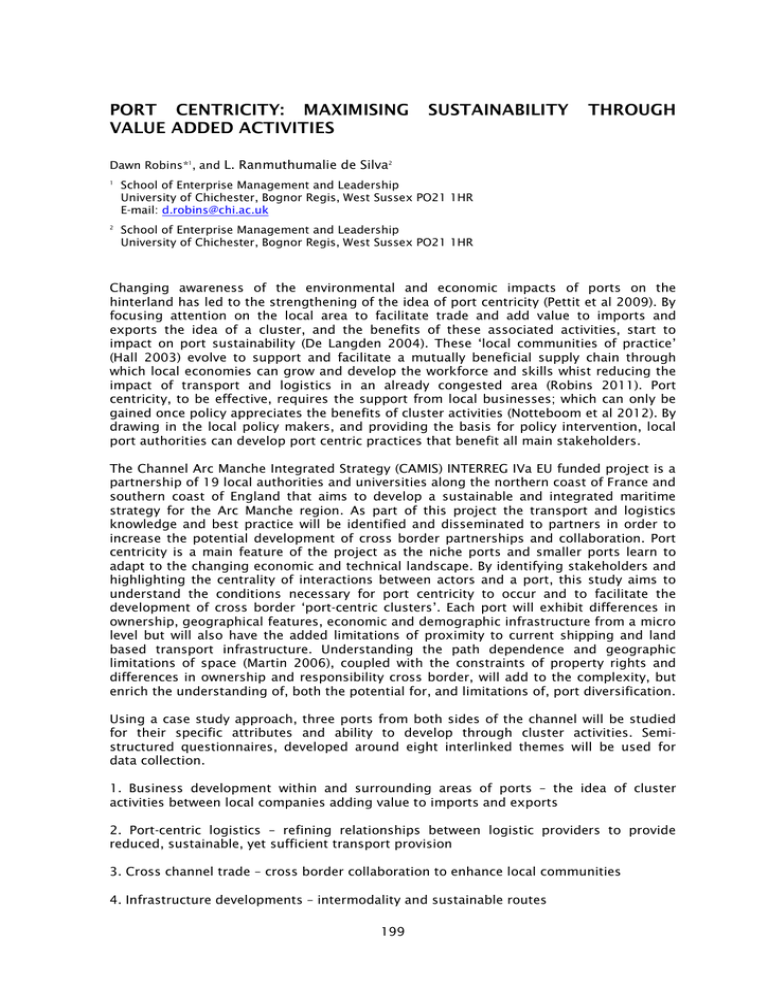PORT CENTRICITY: MAXIMISING SUSTAINABILITY THROUGH VALUE ADDED ACTIVITIES L. Ranmuthumalie de Silva
advertisement

PORT CENTRICITY: MAXIMISING VALUE ADDED ACTIVITIES SUSTAINABILITY THROUGH Dawn Robins*1, and L. Ranmuthumalie de Silva2 1 School of Enterprise Management and Leadership University of Chichester, Bognor Regis, West Sussex PO21 1HR E-mail: d.robins@chi.ac.uk 2 School of Enterprise Management and Leadership University of Chichester, Bognor Regis, West Sussex PO21 1HR Changing awareness of the environmental and economic impacts of ports on the hinterland has led to the strengthening of the idea of port centricity (Pettit et al 2009). By focusing attention on the local area to facilitate trade and add value to imports and exports the idea of a cluster, and the benefits of these associated activities, start to impact on port sustainability (De Langden 2004). These ‘local communities of practice’ (Hall 2003) evolve to support and facilitate a mutually beneficial supply chain through which local economies can grow and develop the workforce and skills whist reducing the impact of transport and logistics in an already congested area (Robins 2011). Port centricity, to be effective, requires the support from local businesses; which can only be gained once policy appreciates the benefits of cluster activities (Notteboom et al 2012). By drawing in the local policy makers, and providing the basis for policy intervention, local port authorities can develop port centric practices that benefit all main stakeholders. The Channel Arc Manche Integrated Strategy (CAMIS) INTERREG IVa EU funded project is a partnership of 19 local authorities and universities along the northern coast of France and southern coast of England that aims to develop a sustainable and integrated maritime strategy for the Arc Manche region. As part of this project the transport and logistics knowledge and best practice will be identified and disseminated to partners in order to increase the potential development of cross border partnerships and collaboration. Port centricity is a main feature of the project as the niche ports and smaller ports learn to adapt to the changing economic and technical landscape. By identifying stakeholders and highlighting the centrality of interactions between actors and a port, this study aims to understand the conditions necessary for port centricity to occur and to facilitate the development of cross border ‘port-centric clusters’. Each port will exhibit differences in ownership, geographical features, economic and demographic infrastructure from a micro level but will also have the added limitations of proximity to current shipping and land based transport infrastructure. Understanding the path dependence and geographic limitations of space (Martin 2006), coupled with the constraints of property rights and differences in ownership and responsibility cross border, will add to the complexity, but enrich the understanding of, both the potential for, and limitations of, port diversification. Using a case study approach, three ports from both sides of the channel will be studied for their specific attributes and ability to develop through cluster activities. Semistructured questionnaires, developed around eight interlinked themes will be used for data collection. 1. Business development within and surrounding areas of ports – the idea of cluster activities between local companies adding value to imports and exports 2. Port-centric logistics – refining relationships between logistic providers to provide reduced, sustainable, yet sufficient transport provision 3. Cross channel trade – cross border collaboration to enhance local communities 4. Infrastructure developments – intermodality and sustainable routes 199 5. Open innovation – technical innovation on operational enhancements 6. Competitiveness – collaborating to increase markets and customer bases without impacting on competitive advantage 7. Human resources – workforce development and skills 8. Image of Ports – public and policy image of the activities of ports One of the major aspects of port centric cluster formation would be the development of local businesses that may have potential to add value to imports and exports of ports and develop technologies to deal with environmental and energy issues related to ports and their stakeholders. This strategy on local business development may have positive impacts on route sustainability since it might reduce unnecessary road haulage. Furthermore, port-centric cluster formation might result in improved port-centric logistics, which may enable achieving efficiency in port operations and intermodal transportation. On the other hand, cross-channel trade may promote port-centric diversification as well as have positive impacts on trans-European route sustainability. In order to reap these benefits it might be important to develop relevant infrastructure, implement competitive port strategies, involve open innovation, address human resource concerns and resolve potential issues associated with the current image of ports as closed industrial hinterlands. Hence, it is believed that these eight themes will enable investigating how to facilitate port-centric cluster formation, which will result in maximising productivity, reducing congestion and increasing sustainability. Once completed, the research will be disseminated to both ports and policy makers in both countries to facilitate the understanding of the potential areas for sustainable growth at the local and cross border level. Understanding the limitations and barriers to port centricity and the specific attributes necessary for individual activities to occur will enable stakeholders to choose from a menu of activities that will suit each individual requirement. References De Langen P.W. 2004. The Performance of Seaport Clusters; A Framework to Analyze Cluster Performance and Application to the Seaport Clusters in Durban, Rotterdam and the Lower Mississippi. ERIM, Rotterdam. Hall P.V. 2003. Regional institutional convergence? Reflections from the Baltimore waterfront Economic Geography, 79:347–363 Martin R. and Sunley P. 2006. Path dependence and regional economic evolution. Journal of Economic Geography, 6:603–618 Notteboom T., De Langden P., and Jacobs W. 2012. Institutional plasticity and path dependence in seaports: interactions between institutions, port governance reforms and port authority routines. Available online 2 June 2012, ISSN 0966-6923, 10.1016/j.jtrangeo.2012.05.002. (http://www.sciencedirect.com/science/article/pii/S0966692312001329) Pettit S. J. and Beresford A. K. C. 2009. Port development: from gateways to logistics hubs. Maritime Policy & Management 36:3, 253-267 Robins D. 2011. Developing a transport vision for the Arc Manche: Port Centiric activities in France and the UK. Working document for CAMIS Strand 4 Interreg IVa (https://camis.arcmanche.eu/documents/). 200



